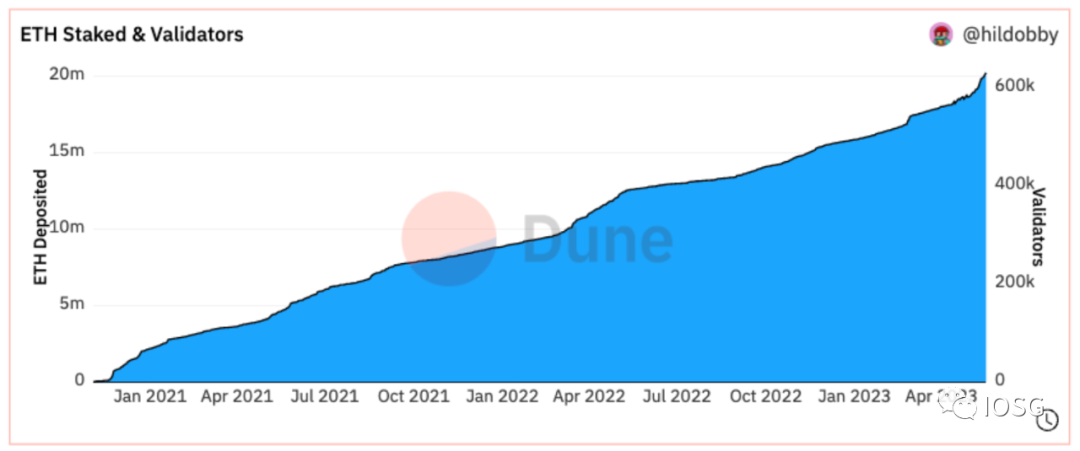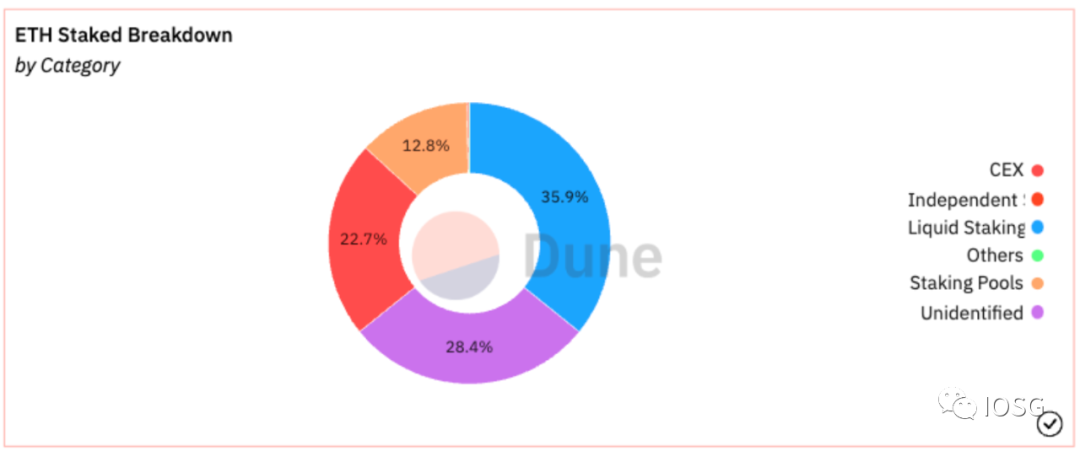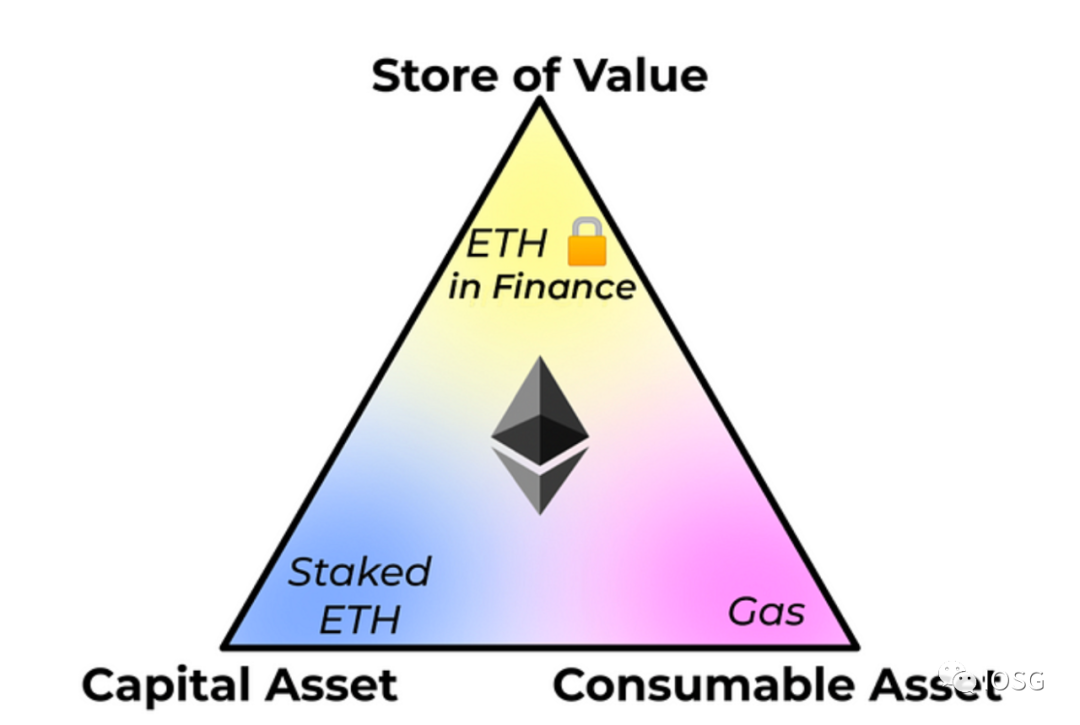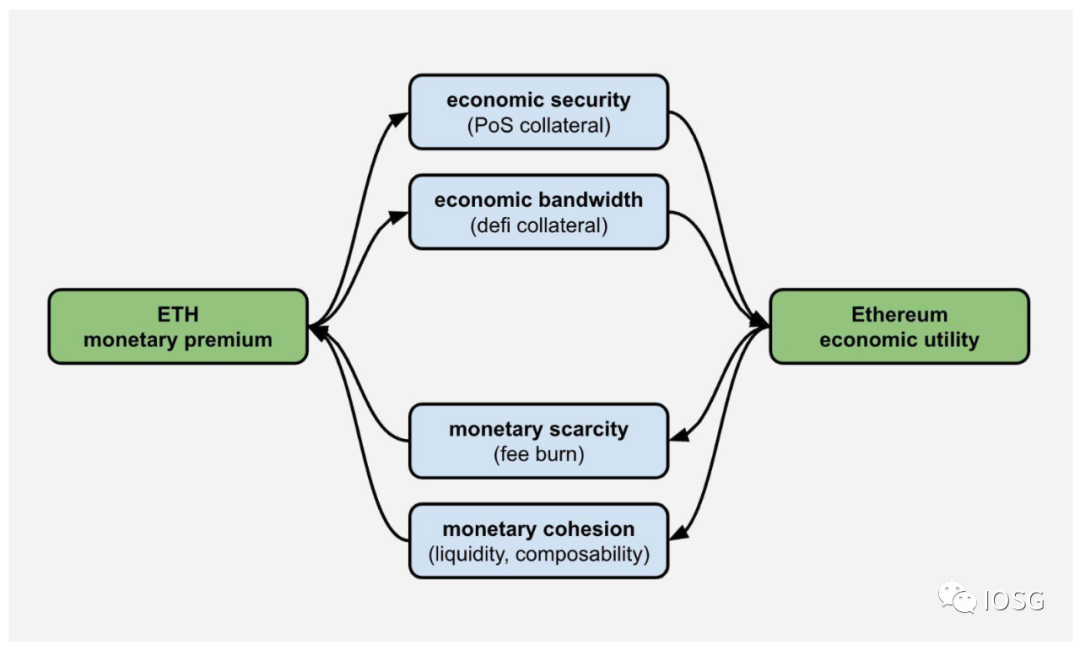After the upgrade in Shanghai, a new competitive landscape has emerged in the Ethereum staking market
Original Title: 《Post-Shapella ------ The Ethereum Staking Market Will Present a Dynamic Competitive Landscape》
Author: Jiawei, IOSG
Abstract
Shapella has released liquidity, and the pressure for withdrawals has recently eased, with a long-term positive outlook on the staking rate;
Driven by events, price wars, and differentiated target customers, the Ethereum staking market will present a dynamic competitive landscape;
DVT will enhance the robustness and stability of the Ethereum validator set;
The influx of institutional investors will help diversify the Ethereum validator set;
Although the staking track has been around for a long time, changes brought about by some significant events may still impact the existing landscape, thus creating implicit investment opportunities.
Introduction
Since Ethereum transitioned to PoS in September last year, there have been two significant protocol upgrades this year: Shapella and Cancun. The former mainly supports validator withdrawals, closing the loop for Ethereum staking; the latter will introduce Data Blob as an early groundwork for data sharding.
Now, more than a month has passed since the successful implementation of Shapella. With the activation of withdrawals, some changes and turning points have emerged in the market. The author writes this article to combine recent observations from the primary market and present some thoughts on the Ethereum staking track, exploring investment opportunities in this area.

Source: Dune Analytics@hildobby
Let’s quickly browse the market situation. Since the staking activation of the Beacon Chain in December 2020, Ethereum staking has developed well, accumulating over 600,000 validators and about 20 million staked Ethereum (currently valued at over $36 billion), with the network staking rate approaching 17%.

Source: Dune Analytics@hildobby
Currently, liquid staking accounts for 35.9% of all staking categories, with Lido alone capturing 31% of the entire staking market. After large withdrawals from CEXs like Kraken and Coinbase, CEXs still hold a market share of 22.7%.

Source: Dune Analytics@hildobby
The activation of the withdrawal channel by Shapella has inevitably led to market selling pressure. As seen in the above chart, ETH outflows have significantly exceeded inflows since Shapella. The withdrawal pressure has quickly eased, with net ETH inflows exceeding 1 million to date. This aligns with market expectations prior to Shapella. With the release of liquidity, the author believes that Ethereum staking remains an attractive asset management target in the medium to long term, thus maintaining a positive outlook on the increase in staking rates.
Post-Shapella ------ The Ethereum Staking Market Will Present a Dynamic Competitive Landscape
Lido currently dominates the entire staking market, primarily due to its first-mover advantage and the moat established around the network effect. However, the author does not believe that Lido will be the endgame for the liquid staking track or the entire staking track. Shapella is a turning point and a fundamental prerequisite for other staking protocols to compete with Lido.
This section mainly discusses event-driven factors, price wars, and target customer differentiation.
Event-Driven

Source: Dune Analytics@hildobby
Some direct or indirect external events may lead to changes in the staking market landscape.
For example, the custodial staking services provided by centralized exchanges once accounted for over 40% of the market share in 2021, but as liquid staking has developed, their market share has been squeezed and has recently shown an accelerating trend. We speculate this may be due to the following two points:
After the collapse of FTX last November, users' trust in centralized, custodial solutions has declined.
In February this year, under pressure from SEC regulations, Kraken announced the termination of staking services for U.S. customers, leading to withdrawal operations and further raising concerns among users regarding staking service providers within specific jurisdictions.

Source: Nansen
After Shapella, early staking users were able to withdraw and turn to other staking services—the top three entities in the withdrawal queue are all centralized exchanges, reflecting this point.
Price War
In a liquid and free market, the operational logic of traditional business models is manifested. Due to the high degree of homogeneity in the staking market, competitive advantages naturally manifest in factors such as price differences. Users can now withdraw from their original staking services and freely choose other platforms, making competition among staking service providers more intense.

Source: GSR
For example, while SaaS platforms focus on institutional users, Solo Staking has a higher threshold for ordinary users, making the last two options in the table the main choices. Centralized exchanges charge higher service fees for staking, while also presenting a lack of transparency. The advantage of liquid staking lies in its good liquidity. As mentioned above, stETH can almost be used as hard currency to interact with most mainstream DeFi applications and can even be directly exchanged for ETH without waiting in the withdrawal queue. Users will flexibly consider different staking options.
Further into the liquid staking field, compared to competitors Lido and Rocketpool, Puffer offers a lower barrier to entry for node operators and staking fees. Specifically, Puffer only charges a 2.5% fee for stakers, which is 1/4 and 1/6 of Lido and Rocket Pool, respectively. Assuming rewards are similar (currently, rewards across protocols are around 5%, with little difference), the amount of fees charged could be one of the factors determining user choice.
At the same time, the level of integration of LST in various DeFi protocols is also a consideration. This represents implicit Lego yields.

Source: ultrasound.money
In terms of staking yields, Ethereum staking yields consist of consensus layer rewards and execution layer rewards, with the former decreasing as more validators join. The latter is dynamic yield, composed of Tips and MEV, directly related to the activity of the Ethereum network. The total yield from using staking services depends on the proportion of rewards shared between service providers and users, for example, stakefish shares 80% of execution layer rewards with users.
To meet competitive needs, node operators can share as much execution layer yield as possible to increase the protocol's APR, thus attracting users. Restaking, mentioned later, is also one method to improve APR.

Source: Messari
On the supply side of node operators, Rocketpool took the opportunity to launch the Atlas upgrade at the time of the Shapella upgrade—compared to the previous requirement of 16 ETH, current node operators only need to invest 8 ETH to run validation services, further lowering the barrier to entry for node operators (running two 8 ETH Minipools provides over 18% more rewards than running one 16 ETH Minipool). The above chart shows that the activation of Atlas has brought a certain degree of protocol growth to Rocketpool.
Target Customer Differentiation
In the liquid staking field, unlike protocols like Lido and Rocketpool that target crypto-native users (To C), Alluvial has partnered with staking service providers like Coinbase and Figment to launch enterprise-level liquid staking solutions (To B).
After Shapella, the withdrawal channel for staking Ethereum has gradually become clear, which may attract traditional financial institutions' interest in liquid staking. Ethereum liquid staking, as an asset allocation strategy, means having exposure to ETH representing industry Beta, an annual staking yield of about 5%, and additional yields from LST in DeFi. If we consider the yields from Restaking, it could push the cumulative yield from Ethereum staking above 15%.
However, traditional institutions need to conduct due diligence on counterparty risks and complete a series of KYC/AML compliance processes, which current crypto-native liquid staking protocols like Lido cannot meet. This is because liquid staking protocols like Lido do not require permission on the user side, do not audit or check the assets entering Lido, and the assets are mixed together; traditional institutions are highly sensitive to this.
One approach is to adopt enterprise-level liquid staking solutions like Alluvial, while another is to provide non-LST liquidity solutions through external partners.
Looking beyond staking itself, the Ethereum validator set provides the underlying trust that supports its ecosystem, and the influx of institutional investors will help diversify the Ethereum validator set, increase competition, and enhance stability.
DVT Will Enhance the Robustness and Stability of the Ethereum Validator Set

Source: Vitalik Buterin
On the roadmap, after Ethereum completes The Merge, there are still two main changes: first, activating the withdrawal of staked Ethereum in Shapella, and second, incorporating EIP-4844 in Cancun to provide more data space for Rollups. Compared to these two points, DVT (Distributed Validator Technology) has relatively little impact on user perception but is crucial for the robustness and stability of the underlying infrastructure.
Before implementing DVT, a single node corresponds to a single validator. When running a validator, objective environmental network failures or configuration errors may lead to Inactivity or Slashing, resulting in missed rewards. DVT introduces node clusters to maintain a single validator (many-to-one), for example, as long as the threshold of 5/7 active nodes is met, validation is executed, eliminating the possibility of a single point of failure.

Source: rated.network
From a data perspective, Rated provides ratings for various staking service providers based on dimensions such as Proposal Effectiveness, Attestation Effectiveness, and Slashing Record. The overall Effectiveness level of Ethereum validators is about 96.9%, which has not yet reached an ideal level.
Since becoming a Node Operator for Lido requires DAO governance approval, while becoming a Node Operator for Rocketpool does not require permission, it is speculated that the nearly 2% difference in ratings between the two may be due to the varying capabilities of Node Operators.
Recently, Lido has integrated with DVT service providers such as Obol Network and SSV Network for testing. Lido has also introduced a DVT module in the V2 Staking Router, which includes Obol's distributed validator clusters and SSV nodes.
It is foreseeable that DVT, as an underlying infrastructure, will become the industry standard for the staking track in the future, but it is almost imperceptible from the perspective of ordinary users.

Source: clientdiversity.org
In addition to DVT, the diversity of consensus layer and execution layer clients is also important.
Conclusion

Source: David Hoffman
In 1997, Robert Greer proposed three asset classes:
Capital Assets: Assets that can generate value/cash flow, such as stocks and bonds;
Convertible/Consumable Assets: Assets that can be consumed, burned, or converted once, such as oil and coffee;
Value Storage Assets: Assets whose value persists over time/space and have scarcity, such as gold and Bitcoin.
David Hoffman pointed out in 2019 that Ethereum can serve as all three types of assets: staked ETH as capital assets, Gas as consumable assets, and ETH locked in DeFi as value storage assets.

Source: Jon Charbonneau
In February of this year, Jon provided a more detailed classification in the above table:
Staked or restaked ETH, including liquid staking tokens like stETH, represents assets that can generate value/cash flow, serving as capital assets;
Gas expenses for Layer 1 and Layer 2, as well as Layer 2's DA expenses on Layer 1, can be consumed, burned, and serve as consumable assets;
Reserve assets like DAO treasuries, collateral in Ce/DeFi, and NFT transactions, MEV pricing, and token trading pairs serve as accounting units and exchange mediums, with value persisting over time/space, serving as value storage assets.

Source: Justin Drake
From 2019 to 2023, as the Ethereum ecosystem has flourished, the utility of ETH has continuously expanded—visibly reflected in its role as a pricing unit for NFTs, as a Gas Token for Layer 2, MEV, as well as LST and derivatives built on LST, and even extending economic security to middleware through Restaking, bringing value back to stakers.
After Shapella, changes at the protocol level for Ethereum staking have come to a pause, with more stories likely to emerge at the application level. The author believes that although the staking track has been around for a long time, changes brought about by some significant events may still impact the existing landscape, thus creating implicit investment opportunities.










